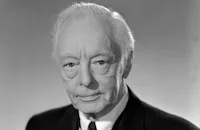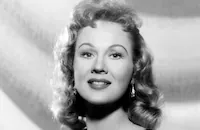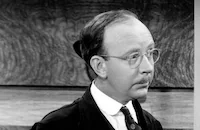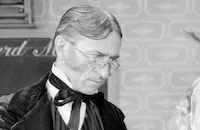Jack London
Brief Synopsis
Cast & Crew
Alfred Santell
Michael O'shea
Susan Hayward
Osa Massen
Harry Davenport
Frank Craven
Film Details
Technical Specs

Synopsis
In Oakland, California, in 1890, Jack London, who dreams of becoming a writer, quits his cannery job after a female employee's hands are crushed in a machinery accident. Mammy Jenny, Jack's maid and surrogate mother, lends him her savings so that he can buy a boat and earn his living hauling oysters from the San Francisco Bay. After he buys the boat from French Frank, who gets a cut of all his business, Jack discovers oyster pirate Mamie stowed aboard, and agrees to a partnership with her. They are later joined by a third partner, Scratch Nelson. Early one morning, the boat pulls into dock after a night's work of stealing from other traps and is fired at from the dock by the police. Scratch is killed, and although Mamie has fallen in love with him, Jack decides that oyster piracy is too dangerous a business and quits. Later, Jack signs on as an able-bodied seaman for a seven-month sealing trip. When his shipmates tease him about his reading habits, weathered sailor Old Tom comes to his defense, and the two become fast friends. One day Jack turns the tables on Red John, a rough practical joker who has harrassed him since his first day aboard ship, and proves his manhood once and for all in a fistfight with the sailor. That night, Jack writes about the sailor, calling him "the sea wolf," and is encouraged in his literary efforts by Old Tom. After his ocean adventures, self-educated Jack enrolls at the University of California at Berkeley. When a teacher selects one of his stories as an example of an overactive imagination, Jack defends his work, stating that having witnessed the vagaries of life, he only writes about cruelty with the hope of alleviating it. Realizing that formal training will not give him the education he craves, Jack leaves school and goes to Dawson City, Alaska, intending to capitalize on the gold strikes in the Yukon. One night in a saloon, Jack meets Greek singer Freda Maloof, and is delighted by her knowledge of Lord Byron's poetry. Although Freda falls in love with Jack, he leaves as soon as news spreads of a major gold strike eighty miles away, determined to earn enough money so that he can spend his time writing instead of working. Eventually Jack ensconces himself in a remote cabin in the wilderness with his German shepherd, Buck, and writes a novel about the dog titled Call of the Wild . Publisher George Brett pays Jack for his manuscript, and when Jack meets his secretary, Charmian Kittredge, he learns that she has already become smitten with him through his writing. Jack soon falls in love with Charmian, and on New Year's Eve, a newspaper publisher asks Jack to cover the Boer War for him. In keeping with her promise that she will never entrap Jack, Charmian encourages him to go. Jack returns, older and wiser, bearing many gifts for Charmian, who still wants to marry him. The next day Maxwell sends Jack to cover the burgeoning war between Japan and Russia, and Charmian again agrees to wait for him. Jack is one of many correspondents in Japan, most of whom believe that Russia will soon make peace with Japan. Jack, however, is suspicious of Japanese intentions, knowing that they are sending troops into Korea. When the Japanese refuse to allow correspondents to travel into Korea, Jack makes a bet with reporter Dick Davis, who is sure that Jack cannot cross the Korean border. Jack disguises himself as a Chinese worker, and gets passage on a "sampan" which crosses the Yellow Sea. Once there, he witnesses Japan's invasion of Korea firsthand. In Korea, Jack is befriended by Oxford-educated Captain Tanaka, who treats him as a guest and outlines for him Japan's plot to take over all of Asia, and ultimately, the world. Jack scoops all of the other papers and sends his report about the Japanese invasion of Korea. After some time, Jack is arrested as a Russian spy, and is thrown into prison with the Russian prisoners. Jack is horrified by the brutal treatment of the prisoners, who are denied water. When the dehydrated prisoners break free of their cell to slake their thirst at a well, the Japanese guards laugh as they gun them down. Davis learns of Jack's arrest and alerts the American government in Washington, D.C. President Theodore Roosevelt demands from the Japanese government Jack's immediate release, but upon his return home, he finds that no one believes his story of the Japanese plan to overtake the world, and is disappointed when Maxwell refuses to print his articles. As Jack and Charmian leave the publisher's office, Charmian reaffirms her love for Jack, and celebrates him for his courage and honesty.

Director
Alfred Santell
Cast

Michael O'shea

Susan Hayward

Osa Massen

Harry Davenport

Frank Craven

Virginia Mayo

Ralph Morgan

Jonathan Hale

Louise Beavers
Leonard Strong

Regis Toomey
Albert Van Antwerp
Paul Hurst
Lumsden Hare

Hobart Cavanaugh
Sarah Padden
Edward Earle
Morgan Conway
Robert Homans

Olin Howlin
Ernie Adams
John Kelly
Arthur Loft
Brooks Benedict
Mei Lee Foo
Robert Katcher

Pierre Watkin
Paul Fung
Charles Lung
Bruce Wong
Eddie Lee
John Fisher
Jack Roper
Sven Hugo Borg
Sid D'albrook
Davison Clark
Harold Minjir

Roy Gordon
Torben Meyer
Charlene Newman
Edmund Cobb
Wallis Clark
Charles Miller

Richard Loo
Dick Curtis
Evelyn Finley
Rose Plumer
Ace, A Dog
Crew
Ben Berk
John W. Boyle
Samuel Bronston
Samuel Bronston
Albert De Courville
Maria Donovan
Bernard Herzbrun
Isaac Don Levine
Charmian London
Arnold Mcdonald
Joseph H. Nadel
Sam Nelson
Edward Padula
Ernest Pascal
Ernest Pascal
Harry Redmond
Frederic Efrem Rich
Ben Winkler
Earl Wooden
William Ziegler

Film Details
Technical Specs

Award Nominations
Best Score
Articles
Virginia Mayo (1920-2005)
She was born Virginia Clara Jones in St. Louis, Missouri on November 30, 1920, and got her show business start at the age of six by enrolling in her aunt's School of Dramatic Expression. While still in her teens, she joined the nightclub circuit, and after paying her dues for a few years traveling across the country, she eventually caught the eye of movie mogul Samuel Goldwyn. He gave her a small role in her first film, starring future husband, Michael O'Shea, in Jack London (1943). She then received minor billing as a "Goldwyn Girl," in the Danny Kaye farce, Up In Arms (1944). Almost immediately, Goldwyn saw her natural movement, comfort and ease in front of the camera, and in just her fourth film, she landed a plumb lead opposite Bob Hope in The Princess and the Pirate (1944). She proved a hit with moviegoers, and her next two films would be with her most frequent leading man, Danny Kaye: Wonder Man (1945), and The Kid from Brooklyn (1946). Both films were big hits, and the chemistry between Mayo and Kaye - the classy, reserved blonde beauty clashing with the hyperactive clown - was surprisingly successful.
Mayo did make a brief break from light comedy, and gave a good performance as Dana Andrews' unfaithful wife, Marie, in the popular post-war drama, The Best Years of Their Lives (1946); but despite the good reviews, she was back with Kaye in The Secret Life of Walter Mitty (1947), and A Song Is Born (1948).
It wasn't until the following year that Mayo got the chance to sink her teeth into a meaty role. That film, White Heat (1949), and her role, as Cody Jarrett's (James Cagney) sluttish, conniving wife, Verna, is memorable for the sheer ruthlessness of her performance. Remember, it was Verna who shot Cody¿s mother in the back, and yet when Cody confronts her after he escapes from prison to exact revenge for her death, Verna effectively places the blame on Big Ed (Steve Cochran):
Verna: I can't tell you Cody!
Cody: Tell me!
Verna: Ed...he shot her in the back!!!
Critics and fans purred over the newfound versatility, yet strangely, she never found a part as juicy as Verna again. Her next film, with Cagney, The West Point Story (1950), was a pleasant enough musical; but her role as Lady Wellesley in Captain Horatio Hornblower R.N. (1951), co-starring Gregory Peck, was merely decorative; that of a burlesque queen attempting to earn a university degree in the gormless comedy, She¿s Working Her Way Through College (1952); and worst of all, the Biblical bomb, The Silver Chalice (1954) which was, incidentally, Paul Newman's film debut, and is a film he still derides as the worst of his career.
Realizing that her future in movies was slowing down, she turned to the supper club circuit in the 60s with her husband, Michael O'Shea, touring the country in such productions as No, No Nanette, Barefoot in the Park, Hello Dolly, and Butterflies Are Free. Like most performers who had outdistanced their glory days with the film industry, Mayo turned to television for the next two decades, appearing in such shows as Night Gallery, Police Story, Murder She Wrote, and Remington Steele. She even earned a recurring role in the short-lived NBC soap opera, Santa Barbara (1984-85), playing an aging hoofer named "Peaches DeLight." Mayo was married to O'Shea from 1947 until his death in 1973. She is survived by their daughter, Mary Johnston; and three grandsons.
by Michael T. Toole

Virginia Mayo (1920-2005)
Quotes
Trivia
Notes
The working title of this film was The Life of Jack London. The film opens and closes with newsreel footage showing the christening of a ship named Jack London. As depicted in the film, Jack London (1876-1916) was a prolific American writer best known for his novels about the wilderness, including Call of the Wild, White Fang and Burning Daylight. This picture marked Samuel Bronston's first entry as a film producer. Jack London's wife Charmian was a technical advisor on this film. Hollywood Reporter news items report that cinematographer Lee Garmes was initially slated as photographer and that some scenes were shot on location at Belden Falls, CA and that Bronston borrowed actress Susan Hayward from Paramount Studios.
Filming was temporarily interrupted in late August 1943 after actor Michael O'Shea suffered a motorcycle accident. In July 1943, O'Shea, who was known on Broadway as Eddie O'Shea, had his name legally changed for films. Jack London marked the first onscreen billing for Virginia Mayo (1920-2005), who, according to modern sources, had appeared as an extra in at least one earlier film. Mayo was married to O'Shea from 1947 until his death in 1973. Jack London was nominated for an Academy Award for Best Music (Scoring of a Dramatic or Comedy Picture).














